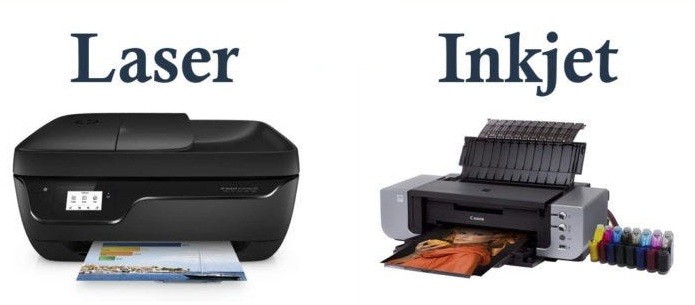Laser Vs. Inkjet Printers: Uncovering the Differences
Introduction
In this modern technologically advanced world, printers have become an essential device for businesses, homes, and educational institutions. The two commonly used types of printers are laser and inkjet printers. Understanding the difference between these two types can make a huge difference in terms of cost, quality, and speed of printing. This guide will provide an in-depth comparison between laser and inkjet printers, helping you make an informed decision about your printer purchase.
What Are Inkjet Printers?
Inkjet printers are a common household device thanks to their simplicity, versatility, and ability to produce high-quality prints. They function primarily by discharging tiny ink droplets onto paper, which results in clear, detailed images and text. Below are some key characteristics:
- Application of Ink: Inkjet printers, in essence, utilize, small droplets of ink that are sprayed directly onto the paper. This mechanism essentially fabricates highly detailed color prints with seamless color transitions.
- Versatility and Quality: These devices are known for their quality output and versatility. They are perfect for printing stunning photos and color documents.

- Adaptability to Paper Types: Capable of adapting to various paper types and sizes, ranging from glossy photo paper to resume paper, they can cater to diverse printing needs.

- Grocery Level and Maintenance: The technological simplicity of inkjet printers makes them a cost-effective choice. These devices are not only affordable, but their smaller size also makes it easier for users to maintain and replace parts when necessary.
At a glance, Inkjet printers offer a compact, versatile, and cost-effective solution to your printing needs, especially when high-quality color prints are a major requirement. They represent the ideal choice for users who require infrequent or moderate-volume printing, with an emphasis on color documents and photographs.
How do Laser Printers Function?
Laser printers operate through an advanced electrostatic digital printing process. This high-performing technology is precisely designed to yield high quality, professional-grade documents. An in-depth view of the operation mechanism of a laser printer involves:
1. Use of a Laser Beam: Initially, a laser beam is used to create an image. This beam moves back and forth across a rotating drum, effectively charging the drum’s surface.
2. Image Creation: An electrostatic image of the page is produced on the drum by discharging particular points.
3. Attraction of Toner Particles: Following the beam-drum interaction, the drum attracts toner particles— these are small, fine, plastic particles of pigment— to charged areas.
4. Paper Contact & Transfer: The toner particles transfer from the drum to the paper. This happens through direct contact of the paper with the drum and via a process of heat application.
5. Crisp Prints: Owing to the precision of the electrostatic process and the quality of the toner particles used, the resulting document is typically crisp, clean, and vibrant.
6. Speed and Efficiency: Notably, laser printers are lauded for their impressive speed and low cost-per-page, especially for high-volume printing, thus making them a popular choice in professional settings.
In understanding the underlying functionality of a laser printer, one can appreciate the technology and precision that powers it, as well as understand why its qualities are ideal for particular printing requirements.
Laser vs. Inkjet: What are the Key Differences?
When engaging in the Laser vs. Inkjet debate, several key factors come to light - print quality, speed, and cost-effectiveness. These dynamics serve as key determinants in the printer selection process.
Print Quality Showdown: Laser vs. Inkjet
Arguably, the most crucial aspect of any printer is its print quality:
- Laser printers excel at producing sharp, clear texts making them excellent for documents, spreadsheets, and more professional outputs.
- Inkjet printers, on the other hand, garner the spotlight when it comes to color precision and gradation. They are typically the go-to option for vibrant color printing – including photos, posters, and marketing materials.
Speed Matters: Laser Printers vs. Inkjet Printers
The speed of a printer is vital, particularly in a fast-paced, productivity-driven environment.
- Laser Printers: Known for their exceptional speed, laser printers work at a brisk pace, making them suitable for workplace settings where large-volume printing is a common practice.
- Inkjet Printers: While they do not match up to the speed of laser printers, inkjet printers still deliver at a decent pace, especially when printing in black and white.
Long-Term Cost Evaluation: Laser or Inkjet?
The initial purchase cost only signifies one aspect of your printer investment. Other running costs come into play over time.
- Laser Printers: Although initially expensive, they deliver a lower cost per page and are typically more cost-efficient in high-volume printing scenarios.
- Inkjet Printers: Inkjet printers, whilst generally cheaper to buy, could incur higher running costs over time as ink cartridges are comparatively more expensive than toner cartridges in terms of cost per page.
Hence, when picking between a laser and inkjet printer, these crucial differences in print quality, speed, and cost must guide your decision.
Who Should Choose What: Making an Informed Decision?
Choosing the right printer can be a complex task given the distinct features of laser and inkjet printers. This decision majorly depends on who will be using the printer and for what purpose. Below, we explore various user scenarios and make suggestions according to their specific needs.
The Home User: Is a Laser Printer a Good Choice?
When it comes to home use, factors such as print versatility, initial cost, and space are crucial. Here are some points to consider:
- Assignment and project needs: Home-based users often require printers for assignments and projects which include graphics and colored prints. In this case, an inkjet printer might be a better fit due to its ability to handle a variety of vivid colors.
- Space Constraints: Laser printers tend to be larger than their inkjet counterparts. For those short on space, a compact inkjet may be the preferable option.
- Budget: If the upfront cost is a deciding factor, inkjet printers generally hold an advantage, as they typically come at a lower purchase price than laser printers.
Business Needs: Are Inkjet Printers the Answer?
Offices and businesses often have different priorities compared to home users. Here's what you should consider:
- Volume of Printing: For businesses that need heavy-duty printing, laser printers often offer a lower cost per page and faster print speeds.
- Document type: If your business frequently prints text-heavy documents, a laser printer's sharp, high-quality text output could be a boon. But if you need to print high-quality images or photos, an inkjet printer may yield better results.
- Long term cost: Laser printers have a higher upfront cost but lower running costs. This can provide significant cost savings in the long run for businesses with high-volume printing needs.
Graphic Designers' Conundrum: Laser or Inkjet?
Graphic designers often need highly detailed and vibrant color output. Here’s what to consider:
- Print Quality: For those in the graphic design industry, the superior photo quality and color accuracy of inkjet printers might be non-negotiable.
- Paper Type: Inkjets offer greater flexibility in printing on a variety of paper types, including glossy and textured paper which is often important in design work.
Before making a decision, be sure to assess your needs, priorities and funds available for both the purchase and maintenance of the printer.
Conclusion
Choosing between a laser and an inkjet printer largely depends upon your requirements and budget. Inkjet printers deliver high-quality color and photo prints, while laser printers are more suitable for high-volume text documents. Consider running costs, print quality, print speed, and your specific needs to make an informed selection. It’s important to choose a printer that fits your printing style and frequency.
Related FAQs about what is the difference between laser and ink printers
Which printer type is more environmentally friendly, laser, or inkjet?
While both printer types have their environmental impact, studies suggest that inkjet printers consume less energy compared to laser printers during operation. However, the waste produced from disposed ink cartridges also presents environmental challenges. In terms of sustainability, it's critical to factor in energy use, consumable waste, and the device's lifecycle.
Can both laser and inkjet printers print in color?
Yes, both laser and inkjet printers can print in color. However, the quality of color prints varies between the two. Inkjet printers are typically renowned for producing superior color prints and images, while laser printers are known for crisp text and fast printing speeds.
Which type of printer is better for printing high-quality photos?
Inkjet printers are generally considered better for printing high-quality photos. They rely on liquid ink that can blend colors smoothly on paper, resulting in more detailed and vibrant photo prints compared to typical laser printers.


